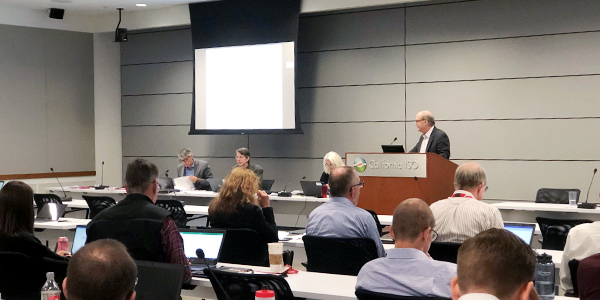By Hudson Sangree
FOLSOM, Calif. – Members of CAISO’s Market Surveillance Committee and stakeholders wrangled over systemwide market power and ways to limit it during an occasionally testy two-hour exchange Monday.
In March, ISO staff issued an analysis of market power in response to a similar report by the ISO’s Department of Market Monitoring, an independent body within the ISO. The staff analysis found its balancing area was uncompetitive during a limited number of hours in 2018 — primarily during times of peak demand when natural gas generators came online. Hot summer days, especially, allow some suppliers to game the system, staff said.
“If we were to design a systemwide market power mitigation process, how would it look?” Perry Servedio, lead market policy design developer at CAISO, summed up the process.
The DMM’s report had used somewhat different criteria but arrived at similar results and recommended the ISO take action to reduce the conditions in which market power might exist.
To address the findings, the ISO and the Market Surveillance Committee have convened a series of monthly stakeholder meetings with the goal of generating an opinion by October. They’re expected to present their findings on the potential costs and benefits of market-power mitigation to the ISO’s Board of Governors in November.
Among the topics being discussed are how to screen for market power and, if found, how and when to take steps to mitigate it. For instance, should the ISO screen only in the real-time market or also in the day-ahead market? And is it appropriate to mitigate voluntary supply?
Not everyone agrees with the ISO’s market-power assessment.
In a presentation at Monday’s meeting, Market Surveillance Committee member Scott Harvey said the ISO’s test for market power is “very conservative.” Failing to pass it doesn’t show the market is structurally non-competitive, he said.
“The test is designed to err toward over-identifying the potential for the exercise of material market power because it is not possible to apply a more sophisticated test in the time frame of the day-ahead market or real-time,” said Harvey, of FTI Consulting.
Others said the process now underway is moving too quickly toward issuing a November opinion. Instead of the usual straw proposal that’s part of a lengthy stakeholder process, ISO staff are planning to go to the board with a committee opinion, which they jokingly call a “straw dog proposal.”
Michele Kito, a regulatory analyst with the California Public Utilities Commission, told the committee the process seemed rushed.
“My concern is we’re going to go to the board with a (plan) that’s prematurely designed, and they’re going to say, ‘don’t do any further action,’ and I think that is a mistake,” Kito said. She noted many stakeholder initiatives take years to develop and said a measure dealing with market power deserves more consideration.
“I think to prematurely sort of cut the legs out of this, which I kind of anticipate … is a shame,” she said.


